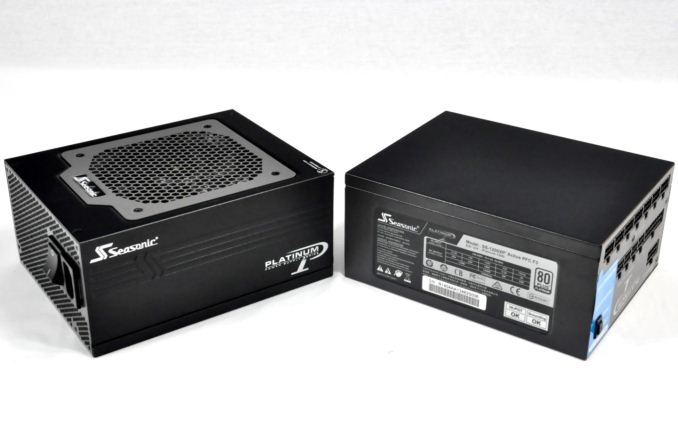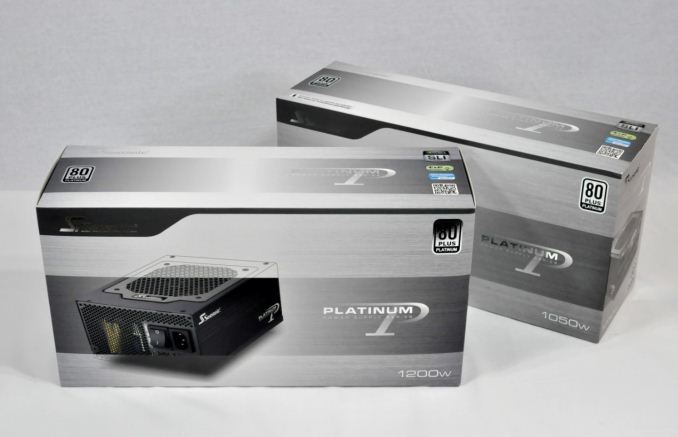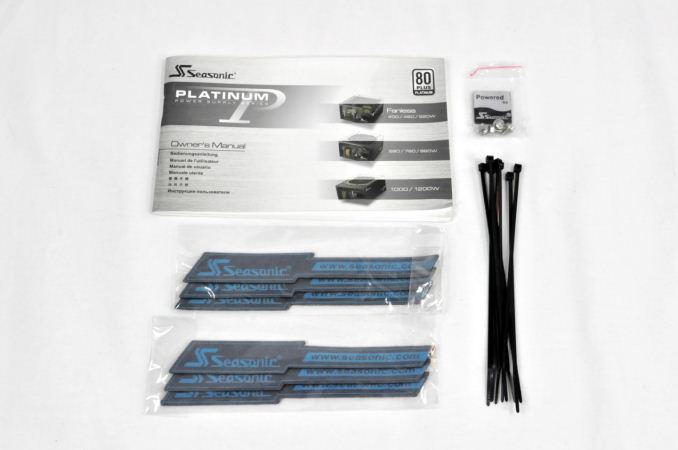Seasonic Platinum SS-1050XP3 & SS-1200XP3 Power Supply Review
by E. Fylladitakis on September 3, 2014 6:00 PM EST- Posted in
- Cases/Cooling/PSUs
- Seasonic
- 1200W
- 80Plus Platinum
- 1050W

Introduction
The 80 Plus program was introduced a decade ago with the aim of promoting the development of more efficient and environmentally friendly computer PSUs. Since then, it has undoubtedly become one of the favorite subjects of PSU marketing teams. Not long ago, an 80 Plus Bronze certification was more than adequate for a mainstream product, with 80 Plus Gold certifications reserved for premium product ranges. Today, 80 Plus Gold certified units can be found retailing at very reasonable prices, slowly but surely making the 80 Plus Bronze certification fit only for low-range products.
There also are numerous 80 Plus Platinum certified products available and even a few 80 Plus Titanium certified units, such as the Corsair AX1500i, are making their appearance, albeit their ludicrous price tags. Meanwhile, the pricing of 80 Plus Platinum certified PSUs has become more reasonable, allowing the manufacturers to effectively implement the technology in their medium and high-end units. Today we have a couple more 80 Plus Platinum PSUs on our test bench.
Seasonic is a very well-known manufacturer of high quality PSUs, so they hardly need an introduction. Today, we are going to look at two of the new additions to their Platinum series, the Platinum SS-1050XP3 1050W and the Platinum SS-1200XP3 1200W. The name of the series is obviously linked with the 80 Plus Platinum efficiency certification of the units and it is their top-tier series, so these two new models also are the best consumer-grade PSUs that Seasonic currently offers. The 1050W and 1200W versions currently retail for $230 and $250 respectively, which are fairly reasonable prices considering their class and power output. How well can they perform though? We will find out in this review.
| Platinum SS-1050XP3 - Power specifications ( Rated @ 50 °C ) | |||||
| AC INPUT | 100 - 240 VAC, 50 - 60 Hz | ||||
| RAIL | +3.3V | +5V | +12V | +5Vsb | -12V |
| MAX OUTPUT | 25A | 25A | 87A | 3A | 0.5A |
| 125W | 1044W | 15W | 6W | ||
| TOTAL | 1050W | ||||
| Platinum SS-1200XP3 - Power specifications ( Rated @ 50 °C ) | |||||
| AC INPUT | 100 - 240 VAC, 50 - 60 Hz | ||||
| RAIL | +3.3V | +5V | +12V | +5Vsb | -12V |
| MAX OUTPUT | 25A | 25A | 100A | 3A | 0.5A |
| 125W | 1200W | 15W | 6W | ||
| TOTAL | 1200W | ||||
Packaging and bundle
We received both units in a long, very well designed cardboard box, with an elegant brushed metal color theme and reflective lettering. Inside the thick cardboard walls of the box, the unit is protected by Polyethylene foam pieces and is wrapped inside a synthetic cloth pouch, which can be repurposed. Information on the performance and the features of the unit can be found on the back of the box.
Both units share the same bundle, consisting of a well written manual, a case badge, four typical 3M mounting screws, a few cable ties, and six cable straps. We imagine that many enthusiasts would prefer black screws instead, but that is a minor misstep.
Both units share almost the same set of cables as well, with the exception that the 1200W version offers ten 6+2 pin PCI-E connectors instead of eight. The cables come supplied in a dual compartment nylon bag with the series logo printed on both sides. With the exception of the 24-pin ATX cable, all of the cables are flat, ribbon-like cables with no sleeving. The 24-pin ATX cables uses black wires as well, but they are individual wires and are covered with black sleeving.














39 Comments
View All Comments
roncat - Thursday, September 4, 2014 - link
Why would you not just use a separate power supply just for the video card? Could you not just make the commons "common" for all PSU, and use the appropriate size for each application to be the most efficient. I assume the PSU outputs are fully floated. Anyone who knows why this may not work (ground loop hell, etc.), please reply.Phillip Wager - Monday, September 8, 2014 - link
this used to be an actual thing that people would do about 10 years ago when sli and crossfire just started coming out. back then everybody had full towers anyway that could house two PSUs the top one would be fore the system and drives and the bottom psu would be for your graphics card. back then 850-1000 watt power supplies were like $600 so getting two 350-500 watt power supplies was a more cost effective option. also cooler master and evga and a lot of brands made power supplies that just had 2-4 VGA eight pins coming off of it and it was marketed to gamers as video card power supplies and it was going to provide more stable power to your videocards and blah blah blah. Now the trend is to make everything SMALLER the majority of regular people who have home pcs their only home pc is actually a laptop or an all-in-one. The trend for gaming pcs is to make small game-console sized PCs and most full sized chasis these days dont even have the screw holes to fit a 2nd power supply on top of the motherboard anymore. and like i said in another post spending $70-150 to save at most 80 dollars of power over the life of the system is hardly worth the initial upfront cost especailly to deal with fitting another bulky heat source in your chasis.bebimbap - Thursday, September 4, 2014 - link
From an economical standpoint, "fixing" the lower efficiencies at almost no power draw is not worth your money. for example, and extra 15w of power 24/365 is only 131kwh most places in the us is about $.10 a kwh. why not just let it go to sleep, or shut off, most computers with ssds boot up to desktop in less than 30 seconds. But I digress, so continuing on, the inefficiency will cost you $13 more year for never using your computer. you have to subtract any time you are at non-idle state. but if you have that power supply for 8 years and not use the computer that entire time of course it adds up to $100 for keeping a computer idle 100% of the time 24/365. But if a psu was made to be 90% efficient at 10w AND 90% efficient at 1200w i guarantee you, you'd pay $200+ more per power supply for that efficiency or it'd be the size of 2 power supplies since you'd basically need 2. wasting 2x the money is also inefficient.Laststop311 - Wednesday, September 3, 2014 - link
230 is pretty expenive for the 1050 watt. I got the 80+ platinum 1000 watt seasonic for 185 45 more dollars for 50 watts is pretty crapIketh - Wednesday, September 3, 2014 - link
yea I was hoping to get a quick explanation of the differences between the 1050W and their 1000W, especially considering the price differenceIketh - Wednesday, September 3, 2014 - link
Nicely written article. The level of detail was superb.Freakie - Wednesday, September 3, 2014 - link
Dat voltage regulation though.I'm actually surprised the ripple was so high, usually Seasonic units completely beat every other unit in their class. But still, only PSU's I will put in my personal systems are Seasonic. Pretty legendary quality and performance.
SammichPG - Thursday, September 4, 2014 - link
While I understand that there's a market for this kind of unit and manifacturers send them for the halo effect, try to get some samples of low wattage units please.Most people will never go over 150-200W real world power consumption and others might be building their own nas so quality and silent power supplies in the 300W range are not only interesting but useful to a much bigger audience.
RussianSensation - Thursday, September 4, 2014 - link
Considering modern GPU's by themselves use 250-280W, and many gamers on our site use 2 of these, just in GPU power alone a solid 500W PSU is the minimum for a modern gaming rig. If all you are building is a core i3 system with no discrete GPU, then sure your system will use only 150W total.I mean really dual overclocked 780s, overclocked i7 5820K and a 1000W PSU that runs 600-700W at load keeps the system quiet.
romrunning - Thursday, September 4, 2014 - link
I think you're validating his point more than not. Today Nvidia and AMD are looking at dropping the power consumption of their GPUs, not increasing. On this site, the R9 285 was listed at 190W, and most of the R9 28x series were listed at 250W. You would have to move up to a huge card (like a Titan or R9 295x2) or dual-GPUs (SLI/Crossfire) to exceed the capabilities of a 450-550W PSU.I would say most gamers are going with the most powerful single card that they can afford, more so than dual-GPU options. Also, I think most gamers don't buy the extreme high-end, but they usually go for the one that provides the most bang-for-the-buck.
So, frankly, these reviews of high-output PSUs benefit very few. I believe more reviews of 450-550W PSUs along with looks at the power requirements of a few typical system builds a gamer might build with his own money would be more beneficial than a review of 1000W+ PSUs. Sure, do a few of them once in a while, but do more of the lower-output, more commonly-used PSUs.